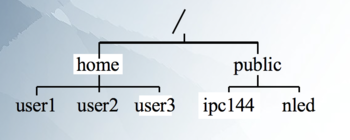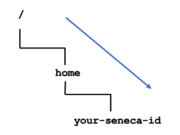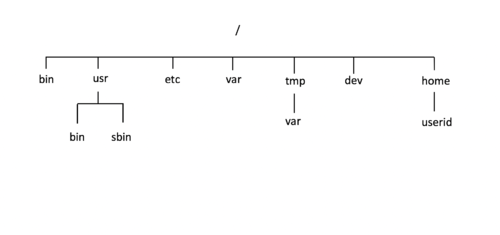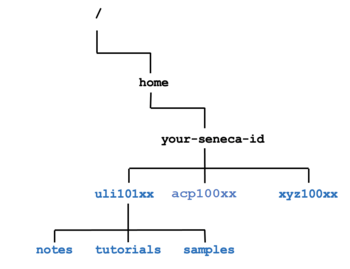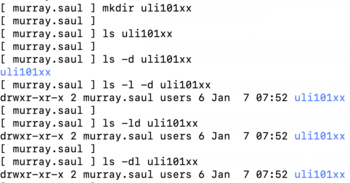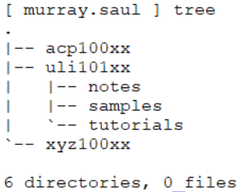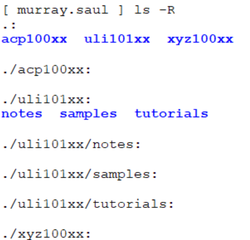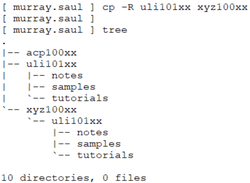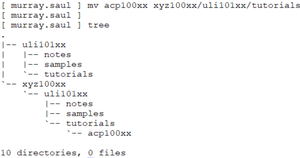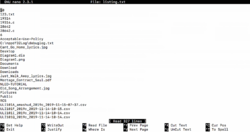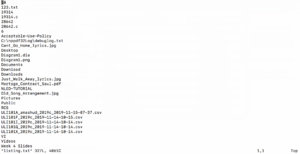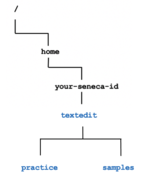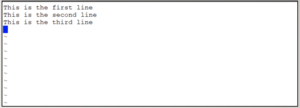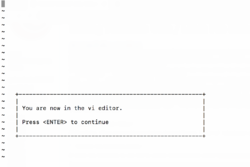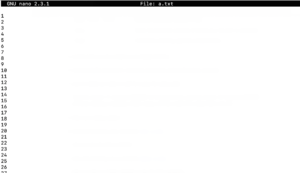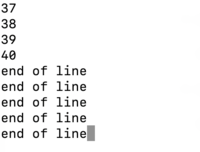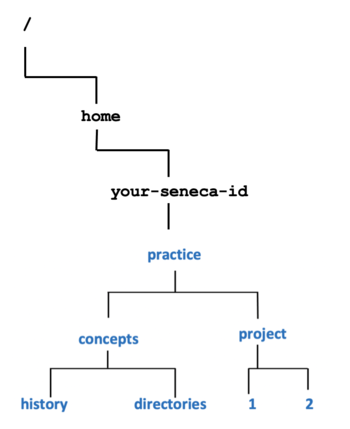Difference between revisions of "Tutorial2: Unix / Linux File Management"
| (18 intermediate revisions by 2 users not shown) | |||
| Line 1: | Line 1: | ||
| + | {{Admon/caution|DO NOT USE THIS VERSION OF THE LAB. This page will no longer be updated.|'''New version here:''' https://seneca-ictoer.github.io/ULI101/A-Tutorials/tutorial2<br />'''Andrew's students please go here:''' http://wiki.littlesvr.ca/wiki/OPS145_Lab_2}} | ||
=UNIX / LINUX FILE MANAGEMENT CONCEPTS= | =UNIX / LINUX FILE MANAGEMENT CONCEPTS= | ||
| − | |||
===Main Objectives of this Practice Tutorial=== | ===Main Objectives of this Practice Tutorial=== | ||
| − | |||
:* Understand the purpose of '''directories''' and '''directory pathnames'''. | :* Understand the purpose of '''directories''' and '''directory pathnames'''. | ||
| − | |||
:* Use common '''Unix / Linux commands''' to perform '''directory management''' tasks. | :* Use common '''Unix / Linux commands''' to perform '''directory management''' tasks. | ||
| − | |||
:* Use '''Text Editors''' to create and modify text files | :* Use '''Text Editors''' to create and modify text files | ||
| − | |||
:* Use Common Unix / Linux commands to '''manage''' and '''manipulate''' text files. | :* Use Common Unix / Linux commands to '''manage''' and '''manipulate''' text files. | ||
| − | |||
===Tutorial Reference Material=== | ===Tutorial Reference Material=== | ||
| Line 26: | Line 21: | ||
|- valign="top" style="padding-left:15px;" | |- valign="top" style="padding-left:15px;" | ||
| − | |colspan="1" |'''Slides:'''<ul><li>Week 2 Lecture 1 Notes:<br> [https:// | + | |colspan="1" |'''Slides:'''<ul><li>Week 2 Lecture 1 Notes:<br> [https://wiki.cdot.senecacollege.ca/uli101/slides/ULI101-2.1.pdf PDF] | [https://wiki.cdot.senecacollege.ca/uli101/slides/ULI101-2.1.pptx PPTX]</li><li>Week 2 Lecture 2 Notes:<br> [https://wiki.cdot.senecacollege.ca/uli101/slides/ULI101-2.2.pdf PDF] | [https://wiki.cdot.senecacollege.ca/uli101/slides/ULI101-2.2.pptx PPTX]</li></ul>'''Tutorials:'''<ul><li>[http://www.cheat-sheets.org/saved-copy/Nano_Cheat_Sheet.pdf Nano Reference Sheet (PDF)]</li><li>[https://www.smashingmagazine.com/2010/05/vi-editor-linux-terminal-cheat-sheet-pdf Vi Reference Sheet (PDF)]</li></ul> |
| Line 64: | Line 59: | ||
To better '''organize''' files (eg. text, images, documents, spreadsheets, programs) within your Matrix account, they should be stored in '''directories'''. To further organize <u>many</u> files, directories<br> may contain '''sub-directories'''. | To better '''organize''' files (eg. text, images, documents, spreadsheets, programs) within your Matrix account, they should be stored in '''directories'''. To further organize <u>many</u> files, directories<br> may contain '''sub-directories'''. | ||
| − | The Unix/Linux file system is '''hierarchical''', like other operating systems such as '''Windows''', ''' | + | The Unix / Linux file system is '''hierarchical''', like other operating systems such as '''Windows''', '''macOS''', etc. In Unix / Linux (as opposed to Windows), there are no drive letters (such as '''C:''', or '''D:'''). |
| − | In Unix / Linux (as opposed to | + | |
| + | All files and directories appear under a single ancestor directory called the "'''root directory'''". | ||
Learning how to issue Linux commands for '''navigating''' and '''manipulating''' directory and files within the the Linux filesystem are '''essential skills''' for Linux users and Linux system administrators (i.e. ''sysadmins''). | Learning how to issue Linux commands for '''navigating''' and '''manipulating''' directory and files within the the Linux filesystem are '''essential skills''' for Linux users and Linux system administrators (i.e. ''sysadmins''). | ||
| − | In the Linux (Unix) OS, the "'''root directory'''" / is the starting directory, and other "''child directories''", "'''grandchild directories'''", etc. can be created as required. The hierarchical structure resembles an "''upside-down tree''". There is actually a command called | + | In the Linux (Unix) OS, the "'''root directory'''" / is the starting directory, and other "''child directories''", "'''grandchild directories'''", etc. can be created as required. The hierarchical structure resembles an "''upside-down tree''". |
| − | + | ||
| + | There is actually a command called <code>tree</code> that displays a "'''directory tree diagram'''"! | ||
=== Directory Pathnames === | === Directory Pathnames === | ||
[[Image:path-name.png|thumb|right|180px|A pathname points to a file system location by '''following the directory tree hierarchy'''.]] | [[Image:path-name.png|thumb|right|180px|A pathname points to a file system location by '''following the directory tree hierarchy'''.]] | ||
| − | + | ''A '''pathname''' is used to specify a '''route to a file''' within the file system. | |
| − | |||
| − | |||
| − | The | + | A pathname '''points''' to a file system location by '''following the directory tree hierarchy''' expressed in a string of characters in which path components, separated by a delimiting character, represent each directory. The '''delimiting character''' is most commonly the slash ("'''/'''").'' Reference: https://en.wikipedia.org/wiki/Path_(computing) |
| − | + | The following table displays and defines '''commonly used directories''' (listed by directory pathname) for for ALL Unix / Linux Filesystems: | |
[[Image:directory-structure-2.png|thumb|right|500px|'''Common directory pathnames'''<br>for for ALL Unix / Linux Filesystems.]]<table cellpadding="5"><tr><th style="border-bottom: 1px solid black;">Directory Pathname</th><th style="border-bottom: 1px solid black;">Purpose</th></tr><tr><td>'''/'''</td><td>Root directory (ancestor to all directories)</td></tr><tr><td>'''/home'''</td><td>Used to store users’ home directories | [[Image:directory-structure-2.png|thumb|right|500px|'''Common directory pathnames'''<br>for for ALL Unix / Linux Filesystems.]]<table cellpadding="5"><tr><th style="border-bottom: 1px solid black;">Directory Pathname</th><th style="border-bottom: 1px solid black;">Purpose</th></tr><tr><td>'''/'''</td><td>Root directory (ancestor to all directories)</td></tr><tr><td>'''/home'''</td><td>Used to store users’ home directories | ||
</td></tr><tr><td>'''/home/username'''</td><td>A '''<u>specific</u>''' User's Home Directory</td></tr><tr><td>'''/bin'''</td><td>Common system binaries (commands) </td></tr><tr><td>'''/usr/bin'''</td><td>Common utilities (commands) for users. </td></tr><tr><td>'''/usr/sbin'''</td><td>Common utilities for system administration </td></tr><tr><td>'''/etc'''</td><td>System administration files (eg. passwd)</td></tr><tr><td>'''/var'''</td><td>Dynamic files (log and mail files)</td></tr><tr><td>'''/tmp , /var/tmp'''</td><td>Temporary files for programs</td></tr><tr><td>'''/dev'''</td><td>Device driver files (terminals, printers, etc.) | </td></tr><tr><td>'''/home/username'''</td><td>A '''<u>specific</u>''' User's Home Directory</td></tr><tr><td>'''/bin'''</td><td>Common system binaries (commands) </td></tr><tr><td>'''/usr/bin'''</td><td>Common utilities (commands) for users. </td></tr><tr><td>'''/usr/sbin'''</td><td>Common utilities for system administration </td></tr><tr><td>'''/etc'''</td><td>System administration files (eg. passwd)</td></tr><tr><td>'''/var'''</td><td>Dynamic files (log and mail files)</td></tr><tr><td>'''/tmp , /var/tmp'''</td><td>Temporary files for programs</td></tr><tr><td>'''/dev'''</td><td>Device driver files (terminals, printers, etc.) | ||
| − | </td></tr></table | + | </td></tr></table> |
| − | + | When you log into your Matrix account, you are automatically directed to your '''home''' directory. This directory is where the user can store files, and create subdirectories to organize their files. | |
| − | When you log into your Matrix account, you are automatically directed to your '''home''' directory. | ||
=INVESTIGATION 1: CREATING & MANAGING DIRECTORIES= | =INVESTIGATION 1: CREATING & MANAGING DIRECTORIES= | ||
| − | + | {{Admon/caution|This weekly tutorial must be completed by Friday in Week 3 by 11:59pm to obtain a grade of 2% towards this course.|}} | |
| − | |||
In this investigation, you will learn how to '''create''', '''navigate''', '''list directory contents''' and '''remove''' directories in your Matrix account. | In this investigation, you will learn how to '''create''', '''navigate''', '''list directory contents''' and '''remove''' directories in your Matrix account. | ||
| − | |||
'''Directory File Naming Rules''' | '''Directory File Naming Rules''' | ||
| Line 107: | Line 99: | ||
* '''Avoid non-alphanumeric characters''', as they may have a special meaning to the system that will make your work more difficult when changing to directories, etc. | * '''Avoid non-alphanumeric characters''', as they may have a special meaning to the system that will make your work more difficult when changing to directories, etc. | ||
* '''Avoid using spaces''' for directory names (consider periods, hyphens, and underscores instead) | * '''Avoid using spaces''' for directory names (consider periods, hyphens, and underscores instead) | ||
| − | |||
===Part 1: Creating Directories === | ===Part 1: Creating Directories === | ||
[[Image:directory-structure-3.png|thumb|right|350px|'''Tree Diagram''' of Directory Structure to Create in your '''Home''' Directory (displayed in blue text).]] | [[Image:directory-structure-3.png|thumb|right|350px|'''Tree Diagram''' of Directory Structure to Create in your '''Home''' Directory (displayed in blue text).]] | ||
| − | Creating subdirectories within your home directory makes it more '''efficient''' to | + | Creating subdirectories within your home directory makes it more '''efficient''' to save and access files on your Linux server. |
| − | A comparison would be rooms in a '''house'''. If there were no rooms, just one large room in a 3,000 square foot house, it would be "messy" and difficult to locate items. Each '''room''' in a house is used to for a | + | A comparison would be rooms in a '''house'''. If there were no rooms, just one large room in a 3,000 square foot house, it would be "messy" and difficult to locate items. Each '''room''' in a house is used to for a '''specific purpose''' to be more productive to perform a task such as a kitchen, bedroom, bathroom, etc. |
| − | You will be creating the following '''directory structure''' within your home directory | + | You will be creating the following '''directory structure''' within your home directory (refer to diagram on the right side). |
| + | '''Perform the Following Steps:''' | ||
| − | ''' | + | '''NOTE:''' For several of the following commands, you will be using '''<u>your</u> Seneca username''' to replace the text:"'''your-seneca-id'''" in a pathname. |
| − | + | For example, if your Seneca user ID was '''mkhan''' then you would display the pathname ''/home/your-seneca-id'' as: '''/home/mkhan''' | |
| − | # '''Login''' to your matrix account (you should know how to do this from performing [https://wiki.cdot.senecacollege.ca/wiki/Tutorial_1:_Using_Your_Matrix_Server_Account#INVESTIGATION_1:_ACCESSING_YOUR_MATRIX_LINUX_ACCOUNT Tutorial 1 INVESTIGATION 1] | + | # '''Login''' to your matrix account (you should know how to do this from performing [https://wiki.cdot.senecacollege.ca/wiki/Tutorial_1:_Using_Your_Matrix_Server_Account#INVESTIGATION_1:_ACCESSING_YOUR_MATRIX_LINUX_ACCOUNT Tutorial 1 INVESTIGATION 1].<br><br> |
| − | # Issue a command to '''confirm''' that you are located in your home directory<br>(you should know how to do this from performing | + | # Issue a command to '''confirm''' that you are located in your home directory<br>(you should know how to do this from performing [https://wiki.cdot.senecacollege.ca/wiki/Tutorial_1:_Using_Your_Matrix_Server_Account#INVESTIGATION_2:_USING_THE_LINUX_SHELL Tutorial 1 INVESTIGATION 2]<br><br> |
# Issue the following Linux command: <span style="color:blue;font-weight:bold;font-family:courier;">mkdir /home/your-seneca-id/uli101xx</span><br>(remember: use <u>your</u> Seneca username instead of "your-seneca-id")<br><br>'''NOTE:''' You should always confirm that you have created a directory.<br>This can be done by issuing the '''ls''' command.<br><br>[[Image:directory-structure-4.png|thumb|right|350px|'''Creating''' and '''Confirming''' the Creation of a Directory.]] | # Issue the following Linux command: <span style="color:blue;font-weight:bold;font-family:courier;">mkdir /home/your-seneca-id/uli101xx</span><br>(remember: use <u>your</u> Seneca username instead of "your-seneca-id")<br><br>'''NOTE:''' You should always confirm that you have created a directory.<br>This can be done by issuing the '''ls''' command.<br><br>[[Image:directory-structure-4.png|thumb|right|350px|'''Creating''' and '''Confirming''' the Creation of a Directory.]] | ||
# Issue the following Linux command: <span style="color:blue;font-weight:bold;font-family:courier;">ls /home/your-seneca-id/uli101xx</span><br><br>There are no contents that are contained in this newly-created directory; therefore, no contents appear. A useful option '''-d''' can be used to confirm that the actual <u>directory</u> has been created as opposed to viewing the contents of the directory.<br><br> | # Issue the following Linux command: <span style="color:blue;font-weight:bold;font-family:courier;">ls /home/your-seneca-id/uli101xx</span><br><br>There are no contents that are contained in this newly-created directory; therefore, no contents appear. A useful option '''-d''' can be used to confirm that the actual <u>directory</u> has been created as opposed to viewing the contents of the directory.<br><br> | ||
| Line 131: | Line 123: | ||
# Issue the following Linux command: <span style="color:blue;font-weight:bold;font-family:courier;">ls -ld /home/your-seneca-id/uli101xx</span><br><br>Is the output from this command the same was the output from the previous command?<br>If so, what does this say about how to use multiple options for Linux commands?<br><br> | # Issue the following Linux command: <span style="color:blue;font-weight:bold;font-family:courier;">ls -ld /home/your-seneca-id/uli101xx</span><br><br>Is the output from this command the same was the output from the previous command?<br>If so, what does this say about how to use multiple options for Linux commands?<br><br> | ||
# Issue the following Linux command to create the '''acp100xx''' and '''xyz100xx''' directories:<br><span style="color:blue;font-weight:bold;font-family:courier;">mkdir /home/your-seneca-id/acp100xx /home/your-seneca-id/xyz100xx</span><br><br>'''NOTE:''' You can create multiple directories by issuing the '''mkdir''' command with <u>multiple arguments</u>.<br><br> | # Issue the following Linux command to create the '''acp100xx''' and '''xyz100xx''' directories:<br><span style="color:blue;font-weight:bold;font-family:courier;">mkdir /home/your-seneca-id/acp100xx /home/your-seneca-id/xyz100xx</span><br><br>'''NOTE:''' You can create multiple directories by issuing the '''mkdir''' command with <u>multiple arguments</u>.<br><br> | ||
| − | # Issue the following Linux command to confirm that those directories have been created:<br><span style="color:blue;font-weight:bold;font-family:courier;">ls -ld /home/your-seneca-id/acp100xx /home/your-seneca-id/xyz100xx</span><br><br>'''Using a FULL pathname starting from the root directory (i.e. /) requires is a LOT of typing!.<br>Since we are already located in our home directory, we don't have to start from<br>the root directory called a "relative" pathname.'''<br><br> | + | # Issue the following Linux command to confirm that those directories have been created:<br><span style="color:blue;font-weight:bold;font-family:courier;">ls -ld /home/your-seneca-id/acp100xx /home/your-seneca-id/xyz100xx</span><br><br>'''Using a FULL pathname starting from the root directory (i.e. /) requires is a LOT of typing!.<br>Since we are already located in our home directory, we don't have to start from<br>the root directory. This is called a "relative" pathname.'''<br><br> |
# We will now create the subdirectories that are contained in the '''uli101xx''' directory.<br>Issue the following Linux command to move to the '''uli101xx''' directory using a '''relative''' pathname:<br><span style="color:blue;font-weight:bold;font-family:courier;">cd uli101xx</span><br><br> | # We will now create the subdirectories that are contained in the '''uli101xx''' directory.<br>Issue the following Linux command to move to the '''uli101xx''' directory using a '''relative''' pathname:<br><span style="color:blue;font-weight:bold;font-family:courier;">cd uli101xx</span><br><br> | ||
# Issue a Linux command to confirm that your current location is in the ''uli101xx'' directory.<br>You should know how to issue this command from a previous tutorial.<br><br> | # Issue a Linux command to confirm that your current location is in the ''uli101xx'' directory.<br>You should know how to issue this command from a previous tutorial.<br><br> | ||
| Line 139: | Line 131: | ||
# Issue a Linux command to confirm that you are now located in your home directory.<br><br>Although we will teach you how to '''remove''' directories and their contents in another investigation,<br>let's remove the created directory structure' and '''recreate''' the same directory structure<br>using just <u>one</u> command using pathnames.<br><br> | # Issue a Linux command to confirm that you are now located in your home directory.<br><br>Although we will teach you how to '''remove''' directories and their contents in another investigation,<br>let's remove the created directory structure' and '''recreate''' the same directory structure<br>using just <u>one</u> command using pathnames.<br><br> | ||
# Issue the following Linux command to remove all of the directories that you have created:<br><span style="color:blue;font-weight:bold;font-family:courier;">rm -r uli101xx acp100xx xyz100xx</span><br><br> | # Issue the following Linux command to remove all of the directories that you have created:<br><span style="color:blue;font-weight:bold;font-family:courier;">rm -r uli101xx acp100xx xyz100xx</span><br><br> | ||
| − | # Issue a Linux command to confirm that the '''uli101xx''', '''acp100xx''' and '''xyz100xx''' | + | # Issue a Linux command to confirm that the '''uli101xx''', '''acp100xx''' and '''xyz100xx''' directories have been removed.<br><br> |
# Issue the following single Linux command to create the entire directory structure:<br><span style="color:blue;font-weight:bold;font-family:courier;">mkdir -p uli101xx/notes uli101xx/tutorials uli101xx/samples acp100xx xyz100xx</span><br><br>'''NOTE:''' The '''-p''' option allows "parent" directories to be automatically created first to then create their subdirectories.<br><br> | # Issue the following single Linux command to create the entire directory structure:<br><span style="color:blue;font-weight:bold;font-family:courier;">mkdir -p uli101xx/notes uli101xx/tutorials uli101xx/samples acp100xx xyz100xx</span><br><br>'''NOTE:''' The '''-p''' option allows "parent" directories to be automatically created first to then create their subdirectories.<br><br> | ||
# Issue the following Linux command to confirm that all of the directories have been created:<br><span style="color:blue;font-weight:bold;font-family:courier;">ls -ld uli101xx/ uli101xx/notes uli101xx/tutorials uli101xx/samples acp100xx xyz100xx</span> | # Issue the following Linux command to confirm that all of the directories have been created:<br><span style="color:blue;font-weight:bold;font-family:courier;">ls -ld uli101xx/ uli101xx/notes uli101xx/tutorials uli101xx/samples acp100xx xyz100xx</span> | ||
| Line 152: | Line 144: | ||
| − | <table align="right"><tr valign="top"><td>[[Image:script-check-1.png|thumb|right|250px|If all | + | <table align="right"><tr valign="top"><td>[[Image:script-check-1.png|thumb|right|250px|If all checks pass, then user performed task correctly and can continue.]]</td><td>[[Image:script-check-2.png|thumb|right|450px|If there is a warning, then feedback is provided to user to correct and re-run checking script.]]</td></table> |
To check for mistakes, a '''shell script''' has been created to check your work. If the checking shell script detects an '''error''', then it will provide feedback and offer constructive feedback on how to fix that problem so you can re-run the checking shell scripts until your work is correct. | To check for mistakes, a '''shell script''' has been created to check your work. If the checking shell script detects an '''error''', then it will provide feedback and offer constructive feedback on how to fix that problem so you can re-run the checking shell scripts until your work is correct. | ||
| Line 200: | Line 192: | ||
=INVESTIGATION 2: MANAGING TEXT FILES= | =INVESTIGATION 2: MANAGING TEXT FILES= | ||
| − | |||
<table align="right"><tr valign="top"><td>[[Image:nano-text-editor-1.png|thumb|right|250px|The '''Nano Text Editor''' is Easy to Operate for Novice Users.]]</td><td>[[Image:vi-text-editor-1.png|thumb|right|300px|The '''vi Text Editor''', although taking longer to master, has outstanding features and allow the user to be more productive with editing text files.]]</td></tr></table> | <table align="right"><tr valign="top"><td>[[Image:nano-text-editor-1.png|thumb|right|250px|The '''Nano Text Editor''' is Easy to Operate for Novice Users.]]</td><td>[[Image:vi-text-editor-1.png|thumb|right|300px|The '''vi Text Editor''', although taking longer to master, has outstanding features and allow the user to be more productive with editing text files.]]</td></tr></table> | ||
| − | |||
Since IT students will be working in the Unix / Linux command line environment, it is useful to learn a least two common command-line '''text editors'''. | Since IT students will be working in the Unix / Linux command line environment, it is useful to learn a least two common command-line '''text editors'''. | ||
Although '''programming students''' can use '''graphical IDE's''' to code and compile programs, they can '''create source code''' using a text editor and '''compile their source code''' in the '''Matrix''' server to generate executable programs (without having to transfer them for compilation or execution). | Although '''programming students''' can use '''graphical IDE's''' to code and compile programs, they can '''create source code''' using a text editor and '''compile their source code''' in the '''Matrix''' server to generate executable programs (without having to transfer them for compilation or execution). | ||
| − | '''Networking and Tech Support students''' can use a text editor to '''edit configuration files'''. These students in upper grades will become familiar with the process of installing, configuring, and running network services and text editors are an important tools | + | '''Networking and Tech Support students''' can use a text editor to '''edit configuration files'''. These students in upper grades will become familiar with the process of installing, configuring, and running network services and text editors are an important tools to help setup but also "tweak" or make '''periodic changes in networking services configuration'''. |
| − | The two most readily-available command line text editors in Linux are '''Nano''' and '''vi'''. | + | The two most readily-available command line text editors in Linux are '''Nano''' and '''vi'''. The Nano text editor would seem like an easier-to-use text editor, but vi (although taking longer to learn) has outstanding features and allow the user to be more productive with editing text files. |
| − | |||
===Part 1: Creating Text Files Using The Nano Text Editor=== | ===Part 1: Creating Text Files Using The Nano Text Editor=== | ||
| + | You will now learn basic editing skills using the '''Nano''' text editor including '''creating''', '''editing''', and '''saving''' text files. | ||
| − | |||
| − | |||
| − | |||
'''Perform the Following Steps:''' | '''Perform the Following Steps:''' | ||
| Line 224: | Line 211: | ||
# Issue a Linux command to check that you correctly created those directories.<br><br> | # Issue a Linux command to check that you correctly created those directories.<br><br> | ||
# Issue the following Linux command to edit a text file called '''mytext.txt''' in the '''linux/practice''' directory:<br><span style="color:blue;font-weight:bold;font-family:courier;">nano textedit/practice/mytext.txt</span><br><br>'''NOTE:''' When using the '''Nano''' text editor, you are placed in '''INPUT''' mode, so you can enter text immediately.<br><br>[[Image:nano-text-editor-2.png|right|400px|thumb|Enter the following text that appears in this diagram.]] | # Issue the following Linux command to edit a text file called '''mytext.txt''' in the '''linux/practice''' directory:<br><span style="color:blue;font-weight:bold;font-family:courier;">nano textedit/practice/mytext.txt</span><br><br>'''NOTE:''' When using the '''Nano''' text editor, you are placed in '''INPUT''' mode, so you can enter text immediately.<br><br>[[Image:nano-text-editor-2.png|right|400px|thumb|Enter the following text that appears in this diagram.]] | ||
| − | # Enter the lines shown in the other diagram of the nano text editor on the right side.<br><br>'''NOTE:''' Refer to the table below for a list of | + | # Enter the lines shown in the other diagram of the nano text editor on the right side.<br><br>'''NOTE:''' Refer to the table below for a list of common '''Nano''' navigation & editing commands:<br><br><table cellpadding="5"><tr><th style="border-bottom: 1px solid black;">Key(s)</th><th style="border-bottom: 1px solid black;">Purpose</th></tr><tr valign="top"><td style="font-family:courier">'''<ctrl><SPACEBAR>''',<br>'''<esc><6>'''</td><td>Move forward/backward one word</td></tr><tr valign="top"><td style="font-family:courier">'''<ctrl><a>''',<br> '''<ctrl><e>'''</td><td>Move to beginning/end of line</td></tr><tr><td style="font-family:courier">'''<ctrl><k>'''</td><td>Cut line</td></tr><tr><td style="font-family:courier">'''<esc>6'''</td><td>Copy Line</td></tr><tr><td style="font-family:courier">'''<ctrl><u>'''</td><td>Paste Cut/Copied Text</td></tr><tr><td style="font-family:courier">'''<ctrl><g>'''</td><td>Display help screen (ctrl-x to exit help screen)</td></tr><tr><td style="font-family:courier">'''<ctrl><x>'''</td><td>Save editing changes and exit</td></tr></table><br> |
# Referring to the table above, practice navigating and editing your entered lines for practice.<br><br> | # Referring to the table above, practice navigating and editing your entered lines for practice.<br><br> | ||
# To '''save''' your editing session, press: <span style="color:blue;font-weight:bold;font-family:courier;"><ctrl>x</span><br><br> | # To '''save''' your editing session, press: <span style="color:blue;font-weight:bold;font-family:courier;"><ctrl>x</span><br><br> | ||
| Line 234: | Line 221: | ||
===Part 2: Creating Text Files Using The vi Text Editor=== | ===Part 2: Creating Text Files Using The vi Text Editor=== | ||
[[Image:vi-screen.png|right|300px|thumb|Using the '''vi''' text editor.]] | [[Image:vi-screen.png|right|300px|thumb|Using the '''vi''' text editor.]] | ||
| − | You will now learn basic editing skills using the '''vi''' ('''vim''') text editor including | + | You will now learn basic editing skills using the '''vi''' ('''vim''') text editor including '''creating''', '''editing''', and '''saving''' text files. |
The '''vi''' ('''vim''') text editor (although taking longer to learn) has outstanding features to increase coding productivity. | The '''vi''' ('''vim''') text editor (although taking longer to learn) has outstanding features to increase coding productivity. | ||
| + | |||
The major different between nano and vi is that '''vi starts in COMMAND LINE mode'''. You need to issue letter commands to enter text. Also you can press colon “: ” in COMMAND mode to enter more complex commands. | The major different between nano and vi is that '''vi starts in COMMAND LINE mode'''. You need to issue letter commands to enter text. Also you can press colon “: ” in COMMAND mode to enter more complex commands. | ||
| Line 272: | Line 260: | ||
===Part 3: Manage & Manipulate Text File Content=== | ===Part 3: Manage & Manipulate Text File Content=== | ||
| − | We conclude this tutorial by learning to '''manage''', '''view''' or '''manipulate the <u>display</u>''' of text files. | + | We conclude this tutorial by learning to '''manage''', '''view''' or '''manipulate the <u>display</u>''' of text files. This is HIGHLY ADVISED in case you only want to view contents and '''NOT''' edit text file contents which can cause accidental erasure of data. |
'''Perform the Following Steps:''' | '''Perform the Following Steps:''' | ||
| Line 305: | Line 293: | ||
# Issue the following Linux command:<br><span style="color:blue;font-weight:bold;font-family:courier;">rm aa.txt b.txt a.txt.bk c.txt</span><br><br> | # Issue the following Linux command:<br><span style="color:blue;font-weight:bold;font-family:courier;">rm aa.txt b.txt a.txt.bk c.txt</span><br><br> | ||
# Issue the '''ls''' command to verify that these files have been removed.<br><br> | # Issue the '''ls''' command to verify that these files have been removed.<br><br> | ||
| − | # Complete the '''LINUX PRACTICE QUESTIONS''' to get additional practice. | + | # Complete the '''LINUX PRACTICE QUESTIONS''' to get additional practice. |
= LINUX PRACTICE QUESTIONS = | = LINUX PRACTICE QUESTIONS = | ||
| Line 314: | Line 302: | ||
simulate a quiz: | simulate a quiz: | ||
| − | https:// | + | * https://wiki.cdot.senecacollege.ca/uli101/files/uli101_week2_practice.docx |
Your instructor may take-up these questions during class. It is up to the student to attend classes in order to obtain the answers to the following questions. Your instructor will NOT provide these answers in any other form (eg. e-mail, etc). | Your instructor may take-up these questions during class. It is up to the student to attend classes in order to obtain the answers to the following questions. Your instructor will NOT provide these answers in any other form (eg. e-mail, etc). | ||
| − | |||
'''Review Questions:''' | '''Review Questions:''' | ||
| − | For each of the following questions, use a pathname starting from the '''root''' directory (i.e. “/”). | + | For each of the following questions, use a pathname starting from the '''root''' directory (i.e. “/”). |
[[Image:tree-diagram.png|right|350px|thumb|]] | [[Image:tree-diagram.png|right|350px|thumb|]] | ||
# Write a single Linux command to create the directory structure starting from your home directory from the diagram displayed on the right. | # Write a single Linux command to create the directory structure starting from your home directory from the diagram displayed on the right. | ||
| − | # Write a Linux command to display a detailed listing of '''history''' directory.<br>How would this command differ if you wanted to also view hidden files as well? | + | # Write a Linux command to display a detailed listing of '''history''' directory.<br>How would this command differ if you wanted to also view hidden files as well? |
| − | # Write a Linux command to change to the '''project''' directory.<br>What command would you issue to return to your home directory? | + | # Write a Linux command to change to the '''project''' directory.<br>What command would you issue to return to your home directory? |
# Write a Linux command to copy the '''project''' directory and its contents to the '''history''' directory. | # Write a Linux command to copy the '''project''' directory and its contents to the '''history''' directory. | ||
# Write a Linux command to move the directory called '''directories''' to the '''history''' directory. | # Write a Linux command to move the directory called '''directories''' to the '''history''' directory. | ||
# Write a Linux command to remove both directories named '''1''' and '''2'''. | # Write a Linux command to remove both directories named '''1''' and '''2'''. | ||
# Write a Linux command to remove the '''concepts''' directory and its contents. | # Write a Linux command to remove the '''concepts''' directory and its contents. | ||
| − | # Write a Linux command to remove the '''concepts''' directory and prompt the user if they want to remove this directory’s contents. | + | # Write a Linux command to remove the '''concepts''' directory and prompt the user if they want to remove this directory’s contents. |
| − | # Write a single Linux command to create the following empty files in the concepts directory: | + | # Write a single Linux command to create the following empty files in the concepts directory: |
| − | # Write a Linux command to view the contents of the myfile.txt text file to prove it is empty. | + | #* '''myfile.txt''' |
| + | #* '''yourfile.txt''' | ||
| + | #* '''thefile.txt''' | ||
| + | # Write a Linux command to view the contents of the myfile.txt text file to prove it is empty. What is the difference between the commands: '''cat''', '''more''' and '''less'''? | ||
# Write a Linux command to sort the contents of a file called '''practice/customers.txt''' | # Write a Linux command to sort the contents of a file called '''practice/customers.txt''' | ||
# Write a Linux command to display the first 4 lines of a file called '''practice/customers.txt''' | # Write a Linux command to display the first 4 lines of a file called '''practice/customers.txt''' | ||
| Line 340: | Line 330: | ||
# Write a Linux command to display unique occurrences of consecutive lines in a file called '''practice/customers.txt''' | # Write a Linux command to display unique occurrences of consecutive lines in a file called '''practice/customers.txt''' | ||
# Create a '''table''' listing each Linux command, useful options that are displayed near the top of this tutorial labelled: '''Tutorial Reference Material''' | # Create a '''table''' listing each Linux command, useful options that are displayed near the top of this tutorial labelled: '''Tutorial Reference Material''' | ||
| − | |||
_________________________________________________________________________________ | _________________________________________________________________________________ | ||
| Line 350: | Line 339: | ||
_________________________________________________________________________________ | _________________________________________________________________________________ | ||
| − | |||
| − | |||
[[Category:ULI101]] | [[Category:ULI101]] | ||
Latest revision as of 20:34, 4 September 2023
Contents
UNIX / LINUX FILE MANAGEMENT CONCEPTS
Main Objectives of this Practice Tutorial
- Understand the purpose of directories and directory pathnames.
- Use common Unix / Linux commands to perform directory management tasks.
- Use Text Editors to create and modify text files
- Use Common Unix / Linux commands to manage and manipulate text files.
Tutorial Reference Material
| Course Notes |
Linux Command/Shortcut Reference |
YouTube Videos | |
| Slides:Tutorials:
|
File Management: | Text Editors / File Content: |
Brauer Instructional Videos: |
KEY CONCEPTS
Unix / Linux Directories
To better organize files (eg. text, images, documents, spreadsheets, programs) within your Matrix account, they should be stored in directories. To further organize many files, directories
may contain sub-directories.
The Unix / Linux file system is hierarchical, like other operating systems such as Windows, macOS, etc. In Unix / Linux (as opposed to Windows), there are no drive letters (such as C:, or D:).
All files and directories appear under a single ancestor directory called the "root directory".
Learning how to issue Linux commands for navigating and manipulating directory and files within the the Linux filesystem are essential skills for Linux users and Linux system administrators (i.e. sysadmins).
In the Linux (Unix) OS, the "root directory" / is the starting directory, and other "child directories", "grandchild directories", etc. can be created as required. The hierarchical structure resembles an "upside-down tree".
There is actually a command called tree that displays a "directory tree diagram"!
Directory Pathnames
A pathname is used to specify a route to a file within the file system.
A pathname points to a file system location by following the directory tree hierarchy expressed in a string of characters in which path components, separated by a delimiting character, represent each directory. The delimiting character is most commonly the slash ("/"). Reference: https://en.wikipedia.org/wiki/Path_(computing)
The following table displays and defines commonly used directories (listed by directory pathname) for for ALL Unix / Linux Filesystems:
| Directory Pathname | Purpose |
|---|---|
| / | Root directory (ancestor to all directories) |
| /home | Used to store users’ home directories |
| /home/username | A specific User's Home Directory |
| /bin | Common system binaries (commands) |
| /usr/bin | Common utilities (commands) for users. |
| /usr/sbin | Common utilities for system administration |
| /etc | System administration files (eg. passwd) |
| /var | Dynamic files (log and mail files) |
| /tmp , /var/tmp | Temporary files for programs |
| /dev | Device driver files (terminals, printers, etc.) |
When you log into your Matrix account, you are automatically directed to your home directory. This directory is where the user can store files, and create subdirectories to organize their files.
INVESTIGATION 1: CREATING & MANAGING DIRECTORIES
In this investigation, you will learn how to create, navigate, list directory contents and remove directories in your Matrix account.
Directory File Naming Rules
Before you learn how to create directories, it is important to understand what represents an appropriate directory filename.
Listed below are some common file-naming rules:
- Unix/Linux characters are case sensitive. It is recommended to be consistent (e.g. use all lowercase letters)
- Adopt a consistent directory naming scheme (this will help you to navigate within your directory structure)
- Make your directory names meaningful
- Avoid non-alphanumeric characters, as they may have a special meaning to the system that will make your work more difficult when changing to directories, etc.
- Avoid using spaces for directory names (consider periods, hyphens, and underscores instead)
Part 1: Creating Directories
Creating subdirectories within your home directory makes it more efficient to save and access files on your Linux server.
A comparison would be rooms in a house. If there were no rooms, just one large room in a 3,000 square foot house, it would be "messy" and difficult to locate items. Each room in a house is used to for a specific purpose to be more productive to perform a task such as a kitchen, bedroom, bathroom, etc.
You will be creating the following directory structure within your home directory (refer to diagram on the right side).
Perform the Following Steps:
NOTE: For several of the following commands, you will be using your Seneca username to replace the text:"your-seneca-id" in a pathname.
For example, if your Seneca user ID was mkhan then you would display the pathname /home/your-seneca-id as: /home/mkhan
- Login to your matrix account (you should know how to do this from performing Tutorial 1 INVESTIGATION 1.
- Issue a command to confirm that you are located in your home directory
(you should know how to do this from performing Tutorial 1 INVESTIGATION 2 - Issue the following Linux command: mkdir /home/your-seneca-id/uli101xx
(remember: use your Seneca username instead of "your-seneca-id")
NOTE: You should always confirm that you have created a directory.
This can be done by issuing the ls command. - Issue the following Linux command: ls /home/your-seneca-id/uli101xx
There are no contents that are contained in this newly-created directory; therefore, no contents appear. A useful option -d can be used to confirm that the actual directory has been created as opposed to viewing the contents of the directory. - Issue the following Linux command: ls -d /home/your-seneca-id/uli101xx
You should now see just the directory listed. You can also combine the -d and -l options to provide more detail regarding the newly-created directory. - Issue the following Linux command: ls -d -l /home/your-seneca-id/uli101xx
How can you confirm from the output of this command that the file uli101xx is a directory? - Issue the following Linux command: ls -ld /home/your-seneca-id/uli101xx
Is the output from this command the same was the output from the previous command?
If so, what does this say about how to use multiple options for Linux commands? - Issue the following Linux command to create the acp100xx and xyz100xx directories:
mkdir /home/your-seneca-id/acp100xx /home/your-seneca-id/xyz100xx
NOTE: You can create multiple directories by issuing the mkdir command with multiple arguments. - Issue the following Linux command to confirm that those directories have been created:
ls -ld /home/your-seneca-id/acp100xx /home/your-seneca-id/xyz100xx
Using a FULL pathname starting from the root directory (i.e. /) requires is a LOT of typing!.
Since we are already located in our home directory, we don't have to start from
the root directory. This is called a "relative" pathname. - We will now create the subdirectories that are contained in the uli101xx directory.
Issue the following Linux command to move to the uli101xx directory using a relative pathname:
cd uli101xx - Issue a Linux command to confirm that your current location is in the uli101xx directory.
You should know how to issue this command from a previous tutorial. - Issue the following Linux command to create the directories called notes, tutorials and samples:
mkdir notes tutorials samples - Issue a Linux command to confirm that those directories have been created
(you should already know how to do this).
There are better ways to create the same directory structure without using the cd command.
Issuing the cd command prior to issuing other commands indicates to others that you are a novice or "newbie".
You can actually lose marks on quizzes or tests if you issue multiple Linux commands to performed tasks that can be performed
using a single Linux command with pathnames. - Issue the following Linux command to return to your home directory: cd
- Issue a Linux command to confirm that you are now located in your home directory.
Although we will teach you how to remove directories and their contents in another investigation,
let's remove the created directory structure' and recreate the same directory structure
using just one command using pathnames. - Issue the following Linux command to remove all of the directories that you have created:
rm -r uli101xx acp100xx xyz100xx - Issue a Linux command to confirm that the uli101xx, acp100xx and xyz100xx directories have been removed.
- Issue the following single Linux command to create the entire directory structure:
mkdir -p uli101xx/notes uli101xx/tutorials uli101xx/samples acp100xx xyz100xx
NOTE: The -p option allows "parent" directories to be automatically created first to then create their subdirectories. - Issue the following Linux command to confirm that all of the directories have been created:
ls -ld uli101xx/ uli101xx/notes uli101xx/tutorials uli101xx/samples acp100xx xyz100xx
Running a Shell Script to Check your Work
Although you are being asked to create the directory structure, you might have made some mistakes:
For Example:
- Forgetting to create a directory.
- Making syntax errors (eg. spelling or mixing up character case)
- Not creating subdirectories within specified directories.
To check for mistakes, a shell script has been created to check your work. If the checking shell script detects an error, then it will provide feedback and offer constructive feedback on how to fix that problem so you can re-run the checking shell scripts until your work is correct.
Perform the Following Steps:
- Make certain that your current directory is your home directory.
- Issue the following Linux command to run a checking script:
~uli101/week2-check-1 - If you encounter errors, then view the feedback to make corrections, and then re-run the checking script. If you receive a congratulation message that there are no errors, then proceed to the next part.
Part 2: Viewing Directory Contents / Copying & Moving Directories
Now that you have learned how to efficiently create your directory structure, you will now learn how to issue Linux commands
to view directory contents as well as copy and move directories.
Perform the Following Steps:
- Issue the following Linux command: tree
NOTE: You should see the directory structure that you created in the previous investigation. You can also issue the tree command using a directory pathname to display the directory structure for a specific scope.
You can also use the -R option for the ls command to display all directories and subdirectories for a specified directory path (referred to as a recursive directory listing). - Issue the following Linux command: ls -lR
What directories do you see? - Issue the following Linux command: ls -lR uli101xx
Note the differences between both of these commands (i.e. using and not using a pathname).
You can copy and move entire directories (and their contents) to other directories. - Issue the following Linux command:
cp -R uli101xx xyz100xx - Issue the following Linux command to display the directory structure of your home directory to confirm you copied the uli101xx directory:
tree - Issue the following Linux command:
mv acp100xx xyz100xx/uli101xx/tutorials - Issue the following Linux command to display the directory structure of your home directory to confirm you moved the acp100xx directory:
tree
Let's run a checking script to see if you moved and copied the directories correctly. - Make certain that your current directory is your home directory.
- Issue the following Linux command run checking script:
~uli101/week2-check-2 - If you encounter errors. make corrections and re-run the checking script until you receive a congratulations message, and proceed to the next investigation.
Part 3: Removing Directories
In this investigation, we will learn how to safely remove directories and their contents.
Perform the Following Steps:
- Confirm that you are located in your home directory.
The rmdir command is used to remove empty directories. - Issue the following Linux command to remove the empty directory called tutorials: rmdir uli101xx/tutorials
- Issue a command to confirm that you removed the tutorials directory.
- Issue the following Linux command to remove the empty directory called uli101xx: rmdir uli101xx
NOTE: You should get an error message, since the uli101xx directory is NOT empty.
To remove non-empty directories, you can use the rm -r command.
The -r option stands for recursive, which can travel down the directory paths and their contents. - Issue the following Linux command to remove the uli101xx directory and its contents: rm -r uli101xx
- Issue the tree command to confirm that the uli101xx directory (contained in your home directory) and its contents have been removed.
NOTE: To safely remove non-empty directories, you can add the -i option which will prompt the user if they wish to remove contents as it your travel recursively down a directory to remove directories and their contents. - Issue the following Linux command (entering "y" when prompted): rm -ri xyz100xx
NOTE: You should have removed all directories that you have created.
Let's run a checking script to confirm that you have correctly removed all of those directories. - Issue the tree command to confirm that all of those recently created directories have been removed.
- Issue the following Linux command to run a checking script to confirm removal of those directories:
~uli101/week2-check-3 - If you encounter errors, make corrections and re-run the checking script until you receive a congratulations message, and proceed to the next INVESTIGATION.
INVESTIGATION 2: MANAGING TEXT FILES
Since IT students will be working in the Unix / Linux command line environment, it is useful to learn a least two common command-line text editors.
Although programming students can use graphical IDE's to code and compile programs, they can create source code using a text editor and compile their source code in the Matrix server to generate executable programs (without having to transfer them for compilation or execution).
Networking and Tech Support students can use a text editor to edit configuration files. These students in upper grades will become familiar with the process of installing, configuring, and running network services and text editors are an important tools to help setup but also "tweak" or make periodic changes in networking services configuration.
The two most readily-available command line text editors in Linux are Nano and vi. The Nano text editor would seem like an easier-to-use text editor, but vi (although taking longer to learn) has outstanding features and allow the user to be more productive with editing text files.
Part 1: Creating Text Files Using The Nano Text Editor
You will now learn basic editing skills using the Nano text editor including creating, editing, and saving text files.
Perform the Following Steps:
- Make certain that you are located in your home directory.
- Create the following directory structure (displayed on the right side) by issuing a single Linux command
(You should know how to do this from the previous INVESTIGATION). - Issue a Linux command to check that you correctly created those directories.
- Issue the following Linux command to edit a text file called mytext.txt in the linux/practice directory:
nano textedit/practice/mytext.txt
NOTE: When using the Nano text editor, you are placed in INPUT mode, so you can enter text immediately. - Enter the lines shown in the other diagram of the nano text editor on the right side.
NOTE: Refer to the table below for a list of common Nano navigation & editing commands:Key(s) Purpose <ctrl><SPACEBAR>,
<esc><6>Move forward/backward one word <ctrl><a>,
<ctrl><e>Move to beginning/end of line <ctrl><k> Cut line <esc>6 Copy Line <ctrl><u> Paste Cut/Copied Text <ctrl><g> Display help screen (ctrl-x to exit help screen) <ctrl><x> Save editing changes and exit - Referring to the table above, practice navigating and editing your entered lines for practice.
- To save your editing session, press: <ctrl>x
- You will be prompted to modify your file: type the letter y for yes.
- The name of the file will be displayed, Press ENTER.to save editing changes for that file name.
NOTE: This prompt for file name allows you to change the name of the file if you wish.
By pressing ENTER, it will accept the default filename. - Perform some more editing operations based on the editing chart above.
- Save your editing session and exit your text editor.
Part 2: Creating Text Files Using The vi Text Editor
You will now learn basic editing skills using the vi (vim) text editor including creating, editing, and saving text files.
The vi (vim) text editor (although taking longer to learn) has outstanding features to increase coding productivity.
The major different between nano and vi is that vi starts in COMMAND LINE mode. You need to issue letter commands to enter text. Also you can press colon “: ” in COMMAND mode to enter more complex commands.
Perform the Following Steps:
- Make certain that you are located in your home directory.
- Issue the following Linux command to edit a text file called othertext.txt in the linux/practice directory:
vi textedit/practice/othertext.txt
NOTE: When using the vi text editor, you are placed in COMMAND mode,
so you need to issue a command to switch to INPUT mode. - Type the following key to enter INPUT mode: i
You should notice you are in INSERT mode by seeing the notification -- INSERT --
at the bottom left-hand side of the application screen. - Enter the line shown in the other diagram of the vi text editor on the right side.
- While on the first line, press the following key to enter COMMAND mode: ESC
You should see the -- INSERT -- notification disappear indicating that you are in COMMAND mode.
NOTE: Refer to the table below for a list of
the most common vi (vim) navigation & editing commands:Key(s) Purpose i Enter INPUT mode <esc> Return to COMMAND MODE x Delete text to the right in COMMAND mode W Move forward one word in COMMAND mode B Move back one word in COMMAND mode dd Cut line in COMMAND mode yy Copy Line in COMMAND mode p / P Paste Cut/Copied Text below/above line in COMMAND mode u Undo previous editing command :help Display help screen in COMMAND mode :x Save editing changes and exit (in COMMAND mode) :w name Save editing changes to "name" in COMMAND mode :q! Abort editing session and exit (in COMMAND mode)
Once you can get used to working in INPUT and COMMAND mode, it is easier to perform
text editing operations in vi via COMMAND mode as opposed to nano! - Type the following keys to copy the current line: yy
- Type the following key to paste the copied line: p
What did you notice? - Type the following keys: u
What did you notice? - Type the following keys: 3p
What did you notice? - Use the up or down arrow keys to move to the second line.
- Type either the w and/or b keys to move the cursor to the beginning of the word: first.
- Type the x keys to remove the word called first.
- Type the i key to enter INSERT mode.
- Type the word: second
- Press the ESC key to enter COMMAND mode.
- Repeat steps 11 to 16 to change the words for line number for lines 3 and 4.
- Move to the 4th line (i.e. last line).
- Type the following keys: dd
What did you notice?
Let's save editing changes and exit the vi text editor. - Type the following keys: :x and press ENTER
What did you notice? - Issue the same command that you performed in Step #2 to confirm that you had properly edited that file.
- Save and exit your vi editing session.
An online tutorial has been created to give you "hands-on" experience on how to use vi text editor. It is recommended that you run this online tutorial in your Matrix account to learn how to create and edit text files with the vi text editor. - Issue the following to run the vi online tutorial:
/home/jason.carman/vi-tutorial - In the tutorial menu, select the first menu item labelled "USING THE VI TEXT EDITOR"
- Read and follow the instructions in the tutorial. Eventually, it will display a simulated vi environment
and will provide you with "hands-on" practice using the vi text editor. As far as this author is aware,
there is NO "hands-on" tutorial for the nano text editor in this particular format. - When you have completed that section, you will be returned to the main menu.
If you want to get extra practice, you can select the menu item labelled "REVIEW EXERCISE". - When you want to exit the tutorial, select the menu option to exit the tutorial.
- It is recommended to try both text editors, and choose the text editor that you feel that is easier to use.
Part 3: Manage & Manipulate Text File Content
We conclude this tutorial by learning to manage, view or manipulate the display of text files. This is HIGHLY ADVISED in case you only want to view contents and NOT edit text file contents which can cause accidental erasure of data.
Perform the Following Steps:
- Make certain that you are located in your home directory.
- Refer to the following table of Text File Management Commands:
Linux Command Purpose touch Create empty file(s) / Updates Existing File's Date/Time Stamp cat Display text file's contents without editing (small files) more , less Display / Navigate within large text files without editing cp Copy text file(s) mv Move / Rename text files rm Remove text file(s) sort Sorts (rearranges) order of file contents when displayed. Content is sorted alphabetically by default. The -nItalic text option sorts numerically, -r performs a reverse sort head , tail Displays the first / last 10 lines of a text file by default. An option using a value will display the number of lines (e.g. head -5 filename will display first 5 lines, tail -5 filename will display last 5 lines). grep Displays file contents that match a pattern uniq Displays identical consecutive lines only once diff file1 file2 Displays differences between 2 files file Gives info about the contents of the file (e.g. file with no extention) find To find files matching specified characteristics: - Issue the following Linux command to create three empty text files in your current directory:
touch a.txt b.txt c.txt - Issue the following Linux command: ls -l a.txt b.txt c.txt
Check the size in the detailed listing to confirm that these newly-created files are empty. - Use the nano text editor to edit the empty file called a.txt.
Type the number "1" and press ENTER. On the second line, type the number "2" and press ENTER.
Continue entering increasing number values until you reach the number 40 on line 40
(refer to the diagram on the right). - Save and exit your editing session.
- Issue the following Linux command: cat a.txt
Can you see all of the contents? - Issue the following Linux command: more a.txt
NOTE: The more command uses the same navigation keys as with the man command
(refer to week 1 notes for reference). Try using keys that you used to navigate the man pages.
What is the advantage of using the more command? - Type the letter "q" to exit the more command.
- Issue the following Linux command: less a.txt
Is there any difference between the more and less commands?
(again press q to quit) - issue the following Linux command: sort a.txt
Why does the output not look what you expected? Why? - Issue the following Linux command: sort -n a.txt
Try the same command using both the -n and -r options to see what happens. - issue the following Linux command: head a.txt
What is the output from this command display? - issue the following Linux command: head -7 a.txt
What is the output from this command display? - issue the following Linux command: tail a.txt
What is the output from this command display?
How would you issue this command to display only the last line contained in that file? - Issue the following Linux command: grep 2 a.txt
What type of output appear? Why did these lines appear (what do they all have in common)? - Edit the a.txt file and add to the bottom 5 new lines each consisting
of the same text: "end of line" (refer to diagram on right). - Save your editing session and exit your text editor.
- Issue the following Linux command: uniq a.txt
What do you notice happened to those newly created lines? - Issue the following Linux command: cp a.txt a.txt.bk
- Issue the following Linux command: cp a.txt b.txt
- Issue the following Linux command: mv a.txt aa.txt
- Issue a Linux command to view the directory contents.
What happened to the file called a.txt? Why? - Issue the following Linux command: file b.txt
What sort of information did it provide? - Issue the following Linux command: diff aa.txt b.txt
Was there any output? If not, why? - Issue the following Linux command: diff aa.txt c.txt
What do you think is the purpose of this output? - Issue the following Linux command: find -P .
What is the output of this command? - Issue the following Linux command:
rm aa.txt b.txt a.txt.bk c.txt - Issue the ls command to verify that these files have been removed.
- Complete the LINUX PRACTICE QUESTIONS to get additional practice.
LINUX PRACTICE QUESTIONS
The purpose of this section is to obtain extra practice to help with quizzes, your midterm, and your final exam.
Here is a link to the MS Word Document of ALL of the questions displayed below but with extra room to answer on the document to simulate a quiz:
Your instructor may take-up these questions during class. It is up to the student to attend classes in order to obtain the answers to the following questions. Your instructor will NOT provide these answers in any other form (eg. e-mail, etc).
Review Questions:
For each of the following questions, use a pathname starting from the root directory (i.e. “/”).
- Write a single Linux command to create the directory structure starting from your home directory from the diagram displayed on the right.
- Write a Linux command to display a detailed listing of history directory.
How would this command differ if you wanted to also view hidden files as well? - Write a Linux command to change to the project directory.
What command would you issue to return to your home directory? - Write a Linux command to copy the project directory and its contents to the history directory.
- Write a Linux command to move the directory called directories to the history directory.
- Write a Linux command to remove both directories named 1 and 2.
- Write a Linux command to remove the concepts directory and its contents.
- Write a Linux command to remove the concepts directory and prompt the user if they want to remove this directory’s contents.
- Write a single Linux command to create the following empty files in the concepts directory:
- myfile.txt
- yourfile.txt
- thefile.txt
- Write a Linux command to view the contents of the myfile.txt text file to prove it is empty. What is the difference between the commands: cat, more and less?
- Write a Linux command to sort the contents of a file called practice/customers.txt
- Write a Linux command to display the first 4 lines of a file called practice/customers.txt
- Write a Linux command to display the last line of a file called practice/customers.txt
- Write a Linux command to match a line containing the pattern Linux in a file called practice/customers.txt
- Write a Linux command to display unique occurrences of consecutive lines in a file called practice/customers.txt
- Create a table listing each Linux command, useful options that are displayed near the top of this tutorial labelled: Tutorial Reference Material
_________________________________________________________________________________
Author: Murray Saul
License: LGPL version 3 Link: https://www.gnu.org/licenses/lgpl.html
_________________________________________________________________________________
